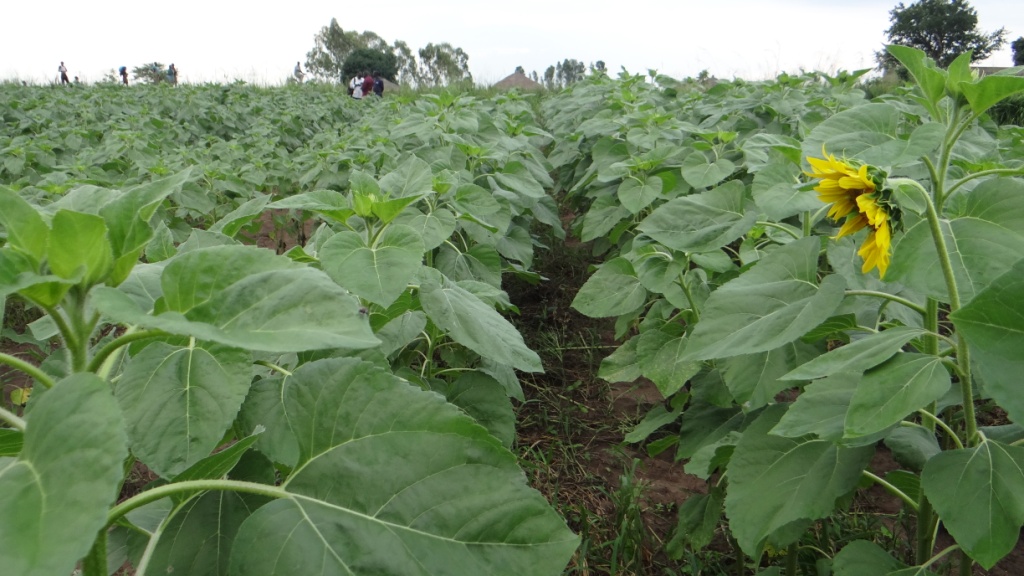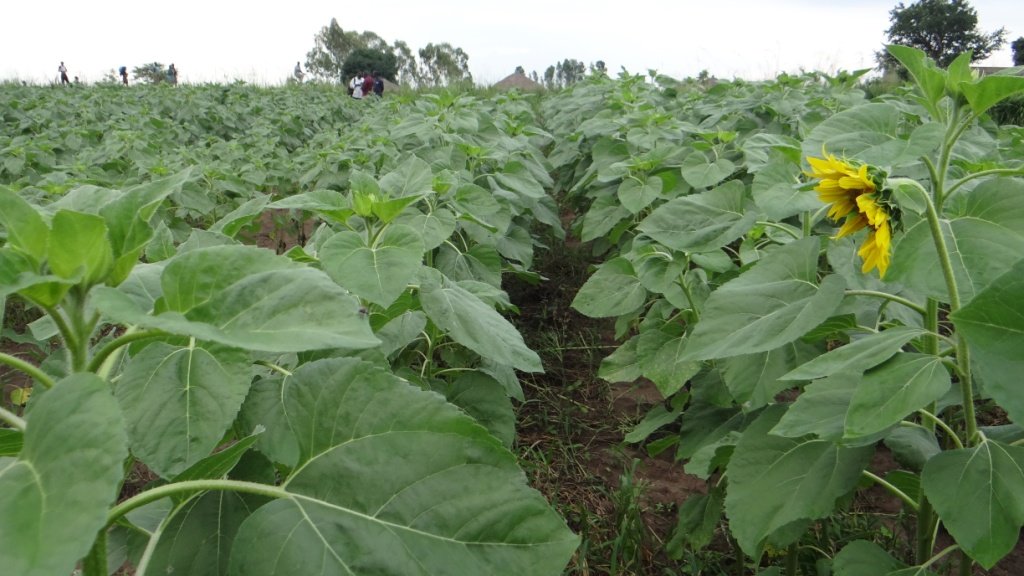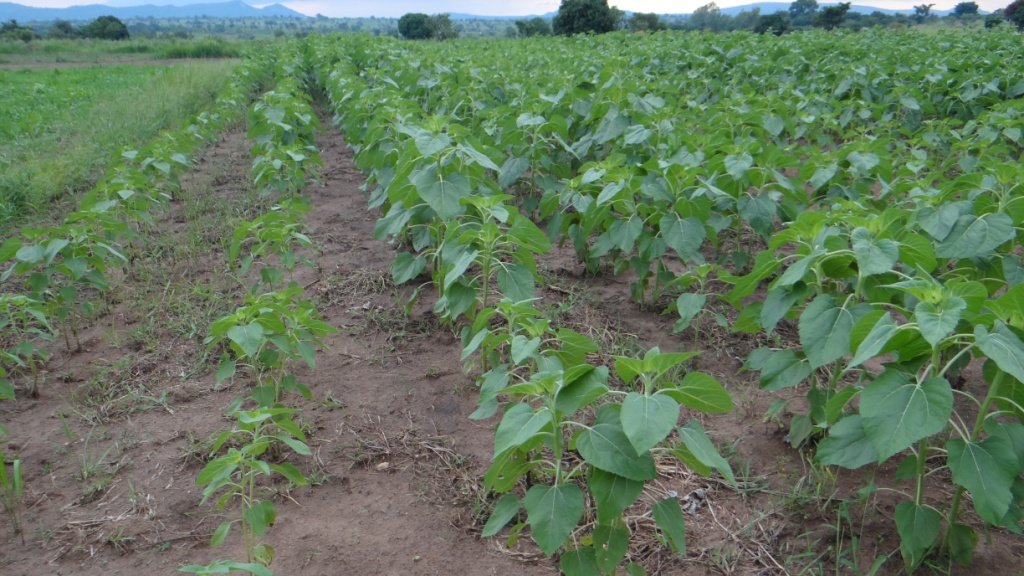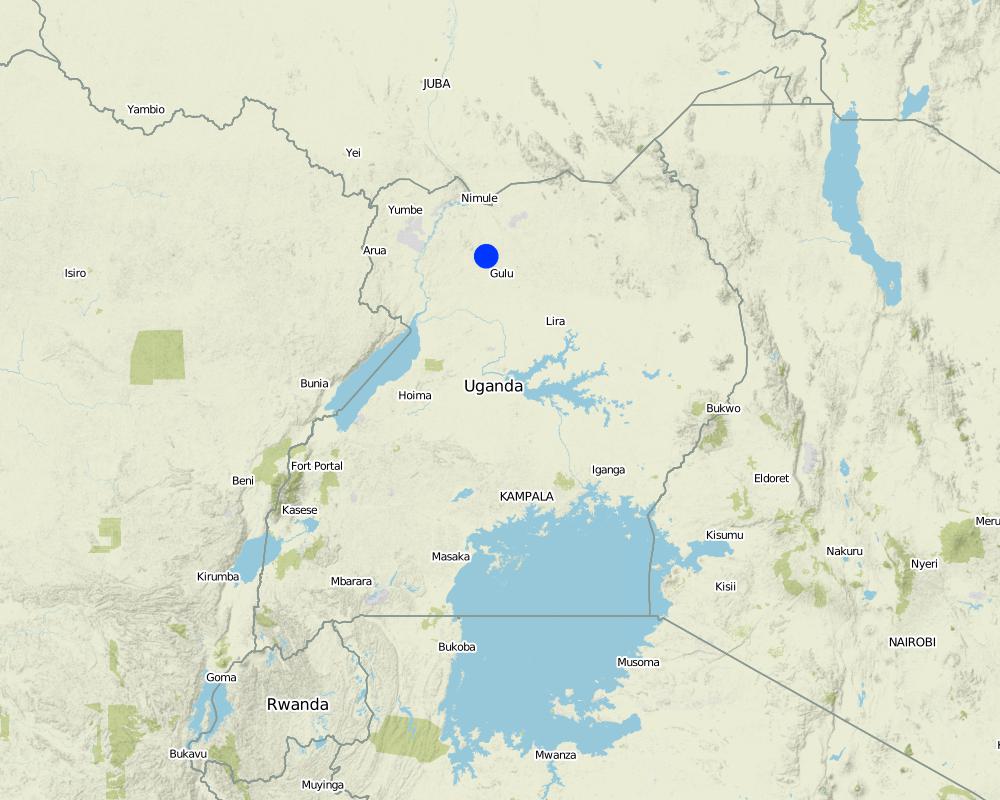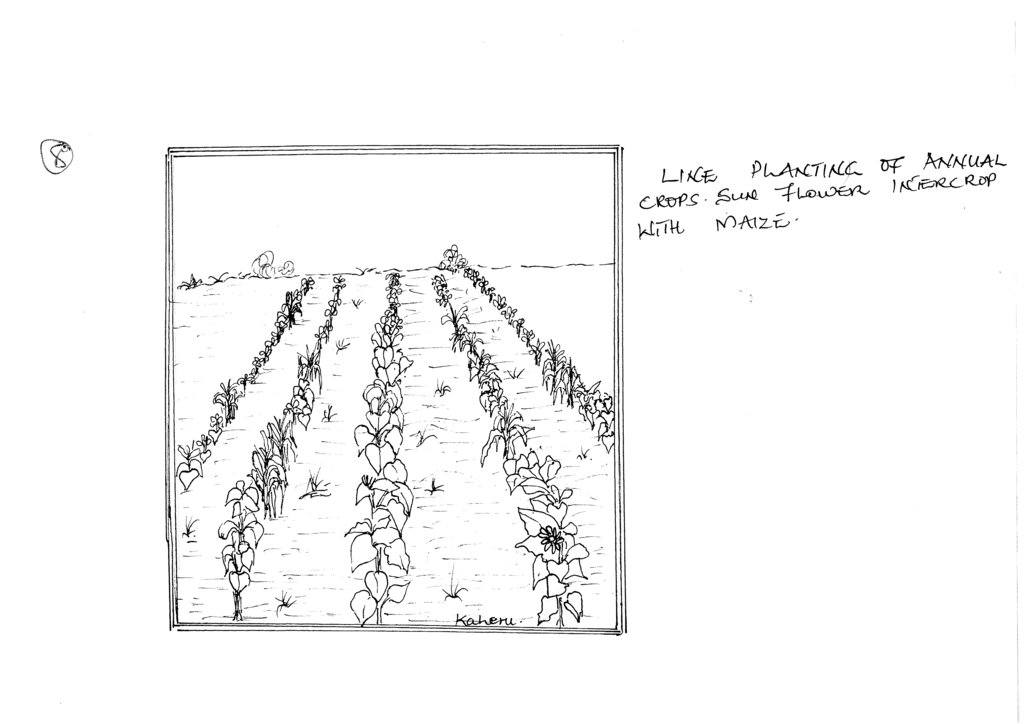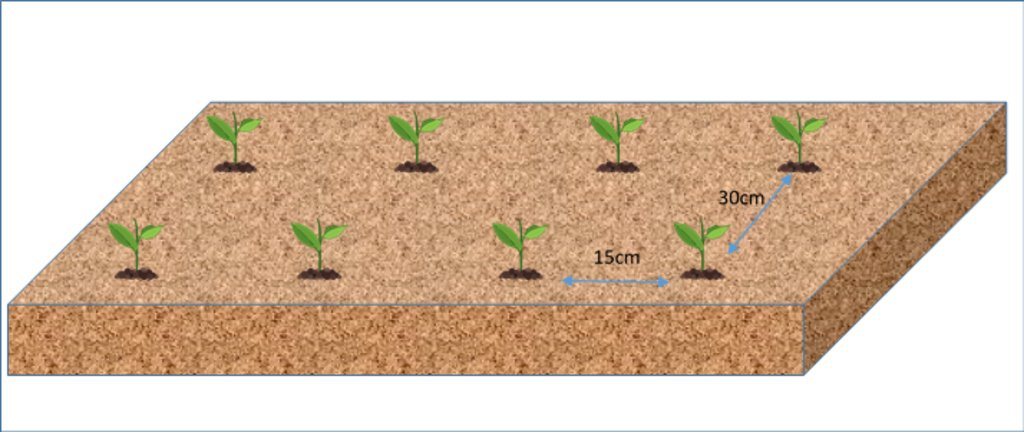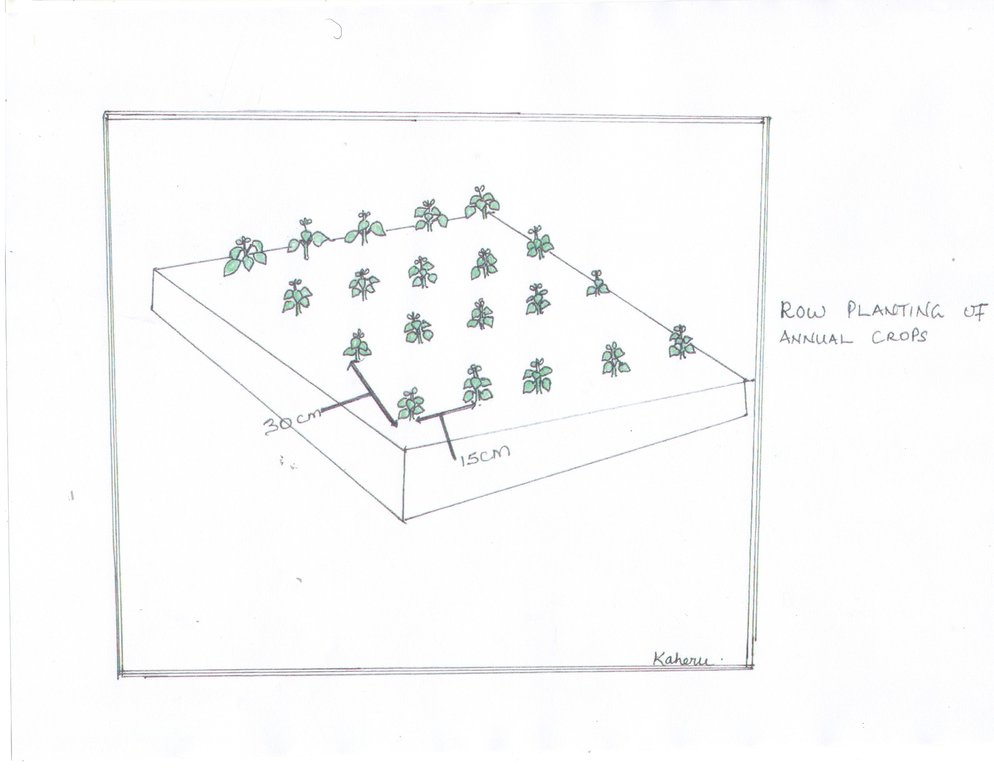Row planting of annual crops [乌干达]
- 创建:
- 更新:
- 编制者: Kamugisha Rick Nelson
- 编辑者: JOY TUKAHIRWA, Richard Otto Kawawa, Sunday Balla Amale, Bernard Fungo
- 审查者: Donia Mühlematter, John Stephen Tenywa, Nicole Harari, Renate Fleiner, Stephanie Jaquet
Pito kodi iline
technologies_2814 - 乌干达
查看章节
全部展开 全部收起1. 一般信息
1.2 参与该技术评估和文件编制的资源人员和机构的联系方式
关键资源人
土地使用者:
Obwona David
Farmer
乌干达
有助于对技术进行记录/评估的项目名称(如相关)
Scaling-up SLM practices by smallholder farmers (IFAD)有助于对技术进行记录/评估的机构名称(如相关)
CDE Centre for Development and Environment (CDE Centre for Development and Environment) - 瑞士1.3 关于使用通过WOCAT记录的数据的条件
编制者和关键资源人员接受有关使用通过WOCAT记录数据的条件。:
是
1.4 所述技术的可持续性声明
这里所描述的技术在土地退化方面是否存在问题,导致无法被认为是一种可持续的土地管理技术?:
否
2. SLM技术的说明
2.1 技术简介
技术定义:
In row planting, crops are planted according to the recommended agronomic spacing to ease management and obtain maximum yields per unit area.
2.2 技术的详细说明
说明:
In this practice, the farmer planted sunflower (Helianthus) seeds at a spacing recommended for the particular variety. Sunflower variety PAN7033 and AGISUN was cultivated on 1 acre of land at a spacing of 15cm within row and 30cm between rows.
To plant crops in a row, the farmer has to ensure that the field is finely prepared. During planting, pegs are fitted at a spacing corresponding to spaces between the rows (30cm), along the width of the field. Ropes are then tied on the pegs along the length of the field. The rope guides the person who will be digging the planting holes, while another person would be dropping the seeds in the holes. After digging the holes in a row, the rope is transferred to the next set of pegs and the process is repeated. These activities require a minimum of 10 people to be working on the farm in order to plant 1 acre of sunflower in a day.
In this way; high yield is obtained from the crop. Activities like weeding, spraying, fertilizer application, harvesting becomes easy hence labor demand is reduced. Although there are elaborate gardening pegs and ropes in the market, the rope and pegs can be made from locally available materials hence reducing costs. Crop planted in rows may reduce surface runoff by planting in a homogenous way and improve maintain a consistent soil cover.
2.3 技术照片
2.4 技术视频
注释、简短说明:
Video showing row planting of annual crops (sunflower) in Amuru District.
日期:
26/05/2017
位置:
Amuru District, Northern Uganda
摄影师的名字:
Issa Aiga
2.5 已应用该技术的、本评估所涵盖的国家/地区/地点
国家:
乌干达
区域/州/省:
Northern Region,Uganda
有关地点的进一步说明:
Amuru District
具体说明该技术的分布:
- 适用于特定场所/集中在较小区域
注释:
Map showing technology site in Northern Uganda.
Map
×2.6 实施日期
注明实施年份:
2015
如果不知道确切的年份,请说明大概的日期:
- 不到10年前(最近)
2.7 技术介绍
详细说明该技术是如何引入的:
- 通过项目/外部干预
3. SLM技术的分类
3.1 该技术的主要目的
- 改良生产
- 创造有益的经济影响
3.2 应用该技术的当前土地利用类型

农田
- 一年一作
每年的生长季节数:
- 2
具体说明:
1st and 2nd season
3.4 供水
该技术所应用土地的供水:
- 雨养
3.5 该技术所属的SLM组
- 轮作制度(轮作、休耕、轮垦)
- 改良的地面/植被覆盖
3.6 包含该技术的可持续土地管理措施

农艺措施
- A1:植被和土壤覆盖层
- A7:其它

结构措施
- S11:其它

管理措施
- M2:改变管理/强度级别
3.7 该技术强调的主要土地退化类型

土壤水蚀
- Wt:表土流失/地表侵蚀

化学性土壤退化
- Cn:肥力下降和有机质含量下降(非侵蚀所致)
3.8 防止、减少或恢复土地退化
具体数量名该技术与土地退化有关的目标:
- 减少土地退化
4. 技术规范、实施活动、投入和成本
4.1 该技术的技术图纸
4.2 有关投入和成本计算的一般信息
具体说明成本和投入是如何计算的:
- 每个技术区域
注明尺寸和面积单位:
1 acre
其它/国家货币(具体说明):
UGX
如相关,注明美元与当地货币的汇率(例如1美元=79.9巴西雷亚尔):1美元=:
3600.0
注明雇用劳工的每日平均工资成本:
5000
4.3 技术建立活动
| 活动 | 时间(季度) | |
|---|---|---|
| 1. | Land opening (Clearing the bush before planting) | Once before establishment |
| 2. | 2 degrees tillage | Once before establishment |
| 3. | Marking line | During establishment |
| 4. | Digging | During establishment |
| 5. | Seeding | During establishment |
| 6. | Weeding | After establishment |
| 7. | Harvesting | After establishment |
4.4 技术建立所需要的费用和投入
| 对投入进行具体说明 | 单位 | 数量 | 单位成本 | 每项投入的总成本 | 土地使用者承担的成本% | |
|---|---|---|---|---|---|---|
| 劳动力 | Labour for planting | Persons | 10.0 | 5000.0 | 50000.0 | 100.0 |
| 设备 | Hoes | Pieces | 3.0 | 10000.0 | 30000.0 | 100.0 |
| 设备 | pegs | Pieces | 6.0 | 2000.0 | 12000.0 | 100.0 |
| 设备 | ropes | Rolls | 1.0 | 10000.0 | 10000.0 | 100.0 |
| 植物材料 | Seeds | Kgs | 30.0 | 5000.0 | 150000.0 | 100.0 |
| 技术建立所需总成本 | 252000.0 | |||||
注释:
This cost is calculated per acre for the technology for soya bean because there are other crops.
4.5 维护/经常性活动
| 活动 | 时间/频率 | |
|---|---|---|
| 1. | Monitoring | Once a year |
| 2. | Harvesting | once a year |
4.6 维护/经常性活动所需要的费用和投入(每年)
| 对投入进行具体说明 | 单位 | 数量 | 单位成本 | 每项投入的总成本 | 土地使用者承担的成本% | |
|---|---|---|---|---|---|---|
| 劳动力 | Labour for harvesting and monitoring. | persons | 5.0 | 5000.0 | 25000.0 | 100.0 |
| 技术维护所需总成本 | 25000.0 | |||||
4.7 影响成本的最重要因素
描述影响成本的最决定性因素:
Labour for planting, weeding and harvesting takes the most of costs.
5. 自然和人文环境
5.1 气候
年降雨量
- < 250毫米
- 251-500毫米
- 501-750毫米
- 751-1,000毫米
- 1,001-1,500毫米
- 1,501-2,000毫米
- 2,001-3,000毫米
- 3,001-4,000毫米
- > 4,000毫米
农业气候带
- 半湿润
5.2 地形
平均坡度:
- 水平(0-2%)
- 缓降(3-5%)
- 平缓(6-10%)
- 滚坡(11-15%)
- 崎岖(16-30%)
- 陡峭(31-60%)
- 非常陡峭(>60%)
地形:
- 高原/平原
- 山脊
- 山坡
- 山地斜坡
- 麓坡
- 谷底
垂直分布带:
- 0-100 m a.s.l.
- 101-500 m a.s.l.
- 501-1,000 m a.s.l.
- 1,001-1,500 m a.s.l.
- 1,501-2,000 m a.s.l.
- 2,001-2,500 m a.s.l.
- 2,501-3,000 m a.s.l.
- 3,001-4,000 m a.s.l.
- > 4,000 m a.s.l.
说明该技术是否专门应用于:
- 不相关
5.3 土壤
平均土层深度:
- 非常浅(0-20厘米)
- 浅(21-50厘米)
- 中等深度(51-80厘米)
- 深(81-120厘米)
- 非常深(> 120厘米)
土壤质地(表土):
- 中粒(壤土、粉土)
土壤质地(地表以下> 20厘米):
- 中粒(壤土、粉土)
表土有机质:
- 中(1-3%)
5.4 水资源可用性和质量
地下水位表:
5-50米
地表水的可用性:
中等
水质(未处理):
良好饮用水
水的盐度有问题吗?:
否
该区域正在发生洪水吗?:
否
5.5 生物多样性
物种多样性:
- 低
栖息地多样性:
- 低
关于生物多样性的注释和进一步规范:
low lying land
5.6 应用该技术的土地使用者的特征
定栖或游牧:
- 定栖的
生产系统的市场定位:
- 生计(自给)
非农收入:
- 低于全部收入的10%
相对财富水平:
- 贫瘠
个人或集体:
- 个人/家庭
机械化水平:
- 手工作业
- 畜力牵引
性别:
- 女人
- 男人
土地使用者的年龄:
- 青年人
- 中年人
说明土地使用者的其他有关特征:
The land user has domestic animals (chicken and animals for traction).
5.7 应用该技术的土地使用者使用的平均土地面积
- < 0.5 公顷
- 0.5-1 公顷
- 1-2 公顷
- 2-5公顷
- 5-15公顷
- 15-50公顷
- 50-100公顷
- 100-500公顷
- 500-1,000公顷
- 1,000-10,000公顷
- > 10,000公顷
这被认为是小规模、中规模还是大规模的(参照当地实际情况)?:
- 小规模的
注释:
Holds approximately 10 acres and rent about 5 acres from other land users.
5.8 土地所有权、土地使用权和水使用权
土地所有权:
- 个人,未命名
土地使用权:
- 租赁
- 个人
用水权:
- 租赁
- 个人
注释:
Owned land =10 cares and leased land =5 acres.
5.9 进入服务和基础设施的通道
健康:
- 贫瘠
- 适度的
- 好
教育:
- 贫瘠
- 适度的
- 好
技术援助:
- 贫瘠
- 适度的
- 好
就业(例如非农):
- 贫瘠
- 适度的
- 好
市场:
- 贫瘠
- 适度的
- 好
能源:
- 贫瘠
- 适度的
- 好
道路和交通:
- 贫瘠
- 适度的
- 好
饮用水和卫生设施:
- 贫瘠
- 适度的
- 好
金融服务:
- 贫瘠
- 适度的
- 好
6. 影响和结论性说明
6.1 该技术的现场影响
社会经济效应
生产
作物生产
注释/具体说明:
High yield and pod filling.
土地管理
注释/具体说明:
Row planting technique.
收入和成本
农业投入费用
注释/具体说明:
Especially on labour.
农业收入
注释/具体说明:
From the sale of harvests (soya and sunflower).
生态影响
土壤
土壤覆盖层
注释/具体说明:
Soil organic matter increased due to application of soya residues
养分循环/补给
注释/具体说明:
Use of the soya bean residues.
土壤有机物/地下C
注释/具体说明:
Soil organic matter increased due to application of soya residues.
6.2 该技术的场外影响已经显现
对场外影响(测量)的评估进行具体说明:
None
6.3 技术对渐变气候以及与气候相关的极端情况/灾害的暴露和敏感性(土地使用者认为的极端情况/灾害)
渐变气候
渐变气候
| 季节 | 增加或减少 | 该技术是如何应对的? | |
|---|---|---|---|
| 年温度 | 增加 | 好 | |
| 季节性温度 | 湿季/雨季 | 增加 | 适度 |
6.4 成本效益分析
技术收益与技术建立成本相比如何(从土地使用者的角度看)?
短期回报:
稍微积极
长期回报:
积极
技术收益与技术维护成本/经常性成本相比如何(从土地使用者的角度看)?
短期回报:
稍微积极
长期回报:
积极
6.5 技术采用
- 1-10%
在所有采用这项技术的人当中,有多少人是自发的,即未获得任何物质奖励/付款?:
- 0-10%
6.6 适应
最近是否对该技术进行了修改以适应不断变化的条件?:
否
6.7 该技术的优点/长处/机会
| 土地使用者眼中的长处/优势/机会 |
|---|
| Easy to establish using a rope which is cheap. |
| Easy to establish and manage with minimum costs. |
| Good at controlling soil and water runoffs |
| The technology can easily be replicated and used by both small scale and large scale farmers. |
| 编制者或其他关键资源人员认为的长处/优势/机会 |
|---|
| Yield potential is high and realized when the spacing is done well by the land user according to recommended spacing. |
6.8 技术的弱点/缺点/风险及其克服方法
| 土地使用者认为的弱点/缺点/风险 | 如何克服它们? |
|---|---|
| Labour intensive at the time of establishment. | Use group labour. |
| Time consuming during establishment. | Use group labour to save on time. |
| Requires technical knowledge especially on the spacing. | Provide information early enough to the land user on the required spacing. |
| 编制者或其他关键资源人员认为的弱点/缺点/风险 | 如何克服它们? |
|---|---|
| The land user does not Incorporate Integrated Soil Fertility Management (ISFM) yet has livestock manure. | Advice to integrate animal manure in row planting. |
7. 参考和链接
7.1 信息的方法/来源
- 实地考察、实地调查
(现场)数据是什么时候汇编的?:
26/05/2017
链接和模块
全部展开 全部收起链接
无链接
模块
无模块


